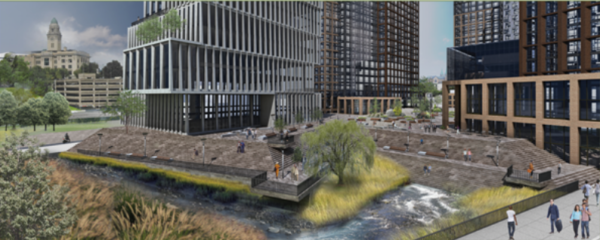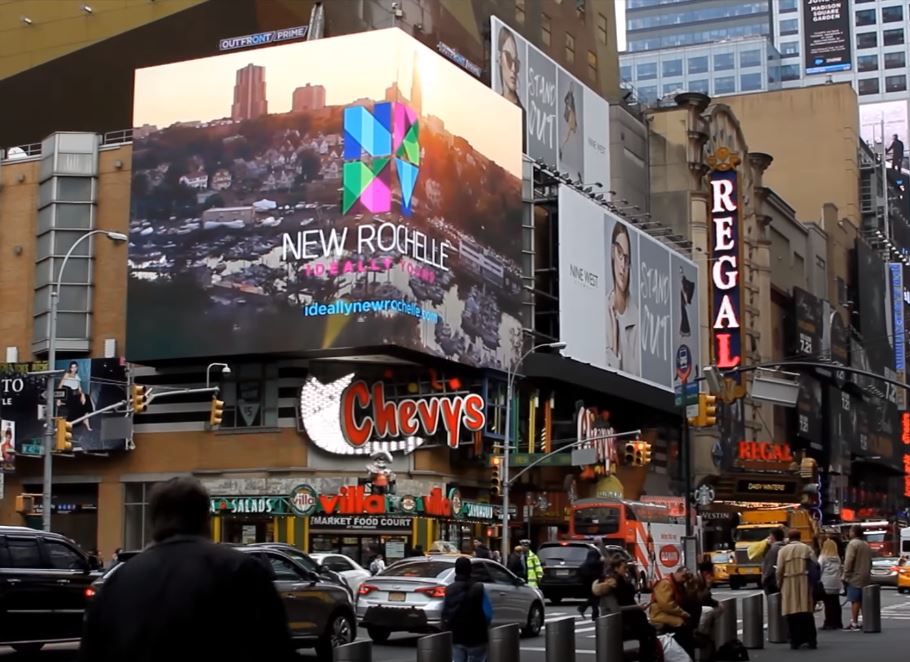Yonkers has found a new buyer willing to build on a 6-acre undeveloped parcel in its downtown known as Chicken Island.

Mayor Mike Spano held a press conference Monday to announce what he said could be a “watershed moment” for the city: AMS Acquistions LLC has agreed to purchase Chicken Island from the municipality for $16 million, pending City Council approval.
AMS principals said at the announcement they aim to turn the property into a downtown epicenter, with a concentration of shopping, dining, apartment buildings, offices and a luxury hotel.
The announcement marks the latest of multiple plans hatched for the property, which gets its name from a small chicken farm that operated there in the 19th century””a time when the Saw Mill River surrounded the lot and made it a small island.
“The city has tried for more than 40 years to develop Chicken Island without success,” Spano said. “This is a game changer for Yonkers, because it proves economic development and a growing tax base is possible beyond the waterfront.”
The most recent big plans for the site came from the city”™s former master developer, Struever Fidelco Cappelli L.L.C. The name represented the three big-name developers in the partnership: New Jersey-based Fidelco Realty Group, Valhalla’s Cappelli Enterprises Inc. and Struever Bros. Eccles & Rouse, a Baltimore developer known for its transformation of that city”™s Inner Harbor.
The group envisioned its own downtown epicenter, branded as River Park Center, with high-rise residential towers, a cinema complex, major retail stores, commercial office space and a stadium to attract a minor league baseball team to Yonkers.
That plan initially faced community opposition, then never got off the ground as the financial crisis in 2008 and subsequent economic downturn stalled development projects throughout the country.
Yonkers called off the master developer partnership in 2013, though last year a reorganized form of the company agreed to fund the $5 million environmental remediation of the brownfield site.
A series of requests for proposal have followed in the years since, but Spano said the city received only vague, under-financed plans. Yonkers changed tack recently, Spano said, and started reaching out directly to established developers in the city to gauge interest.

That included AMS. The company already had expanded its Yonkers presence at the beginning of 2018, when it paid $9.5 million to purchase 86 Main St., a six-story, 70,000-square-foot office building on the southeast corner of Main Street and Buena Vista Avenue across from the Yonkers Metro-North train station. The company also owns 92 Main St., a 78,000-square-foot mixed-use building that was formerly a city trolley barn. That building includes 40 live-work lofts and is home to Chase Bank and Yonkers Brewery.
“Downtown Yonkers is in the midst of a renaissance,” said Michael Mitnick, principal of AMS Acquisitions. “AMS is invested heavily in the growth and expansion of this incredible and unique market.”
Formed in 2012, AMS’ portfolio includes approximately 1.5 million square feet of retail, residential and office space in the tri-state region.
Chicken Island is zoned to allow development of up to 25 stories. Potential buildings there are zoned to allow a wide range of uses as well, the city said, including retail, restaurant, office, colleges and residential.
“Seven years ago the Chicken Island redevelopment plan was dead,” said Spano. “Now we have a workable plan, backed up with hard dollars that the city can use in the short run to fund our schools and essential services, and in the long run we will collect many millions of real estate and income taxes plus take another giant leap forward in revitalizing the downtown.”
The city envisions the development of Chicken Island complementing two nearby public works projects: the building of a new fire station on New School Street and a soon-to-be completed phase of the Saw Mill River daylighting along New Main Street.
AMS paid the city $800,000 as a deposit on the letter of the intent to purchase the property. The balance of the purchase will be paid following the sale’s approval by the city council, Spano said.





















What a great opportunity! This site is Westchester County’s most walkable and transit-rich spot, with a high WalkScore, a hub of Bee-Line Bus system, and 1/4 mile walk/bike to the MetroNorth station via the gorgeous new Saw Mill River-daylighted city parks. LimeBikes are everywhere, although more people would bike with more Protected Bike Lanes/Paths — some of which are already on the drawing board.
Please don’t skimp on height. No reason to restrict the height to 25 stories in the historic heart of Yonkers. New Rochelle and White Plains have 44 stories; Yonkers should build up by offering bonus height in exchange for more affordable apartments.
Let’s do this without adding to traffic congestion. Seattle has shown the way, with lots of population growth (and tax revenues) with more transit — bus — ridership minimizing additional car congestion.
Don’t waste space and money with deck upon deck of car parking on this site. Parking is just a “fertility drug for driving” as Professor Donald Shoup has written. These streets were built for transit (formerly streetcars) and walking, not cars. People want an urban experience riding transit and walking on streets that are narrow and comfortable.
Local businesses need people walking and biking our streets, not driving past them to the malls. Yonkers should embrace the urbanity of this area, not try to turn it into Central Avenue or Executive Blvd. with their oceans of free parking, or even White Plains with its dangerously-wide streets where destinations become too far to walk.
What a clown! More high risers, and no parking garage? “Downtown advocate†your very confused. This is yonkers not Manhattan, not Brooklyn. People want cars and your ideas cause congestion, traffic, and general mayham. You must be con the payroll for the other clown Spano.
Parking will go under the plaza.
I’d say being a clown is shooting yourself in the foot, and that’s what Yonkers does by forcing developers to build so much parking. Instead of keeping these residents nearby, adding to our stores’ tax receipts, we make it super-easy for them to drive away where they give their money to other municipalities. So we get nothing to fund our schools, parks, and streets.
Look at all the buildings along the waterfront. With easy parking most of the residents never walk to local shops. They never hop on a bus to check out the great ethnic restaurants on South Broadway or the fabulous bars and clubs on McLean Avenue. Some of the residents have never been to Warburton Avenue on foot. Instead, they get in their cars and drive to the malls or other towns, clogging our streets even more. And this devalues those streets, like Yonkers Avenue, which is just a car sewer that adds zero value to Yonkers. And again, Yonkers doesn’t get any tax money from thriving businesses.
Brooklyn is an accurate counterpoint to your argument. Downtown Yonkers is just as dense as many Brooklyn neighborhoods, but in Brooklyn parking is scarce. Yet Brooklyn neighborhood’s businesses are thriving, because people can’t easily drive away — even in the face of Amazon. New residents spend time discovering their new home, and learning about and supporting local businesses. We have a wide diversity of ethnic restaurants. In Brooklyn, these are celebrated by new residents. Let’s see that happen in Yonkers.